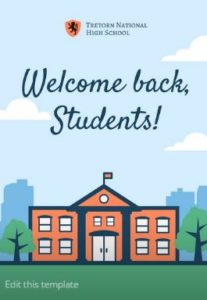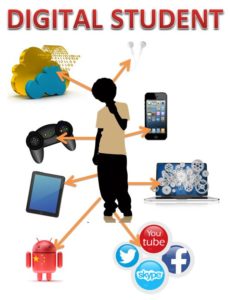A new school year is a fresh start. For students, that means a different teacher and new classmates. For teachers, it’s another chance to make an impact on the lives of kids, turn them into life-long learners or at least let them experience the joy of learning.
In the chaos of getting ready for that all-important first day, it’s tempting to “do things as they’ve always been done” — like lectures, quizzes, student plays, and posters — but more and more teachers want to shake things up by adding innovative activities that differentiate for student learning styles while creatively accomplishing classroom goals.
Here are eleven such activities I’ve collected from colleagues using transformative tools that optimize learning while making students active participants in expected learning outcomes:
Class management
Use the webtool Too Noisy for the first month of class to show students how loud the class can get. Demonstrate how it works by showing that the louder classroom sounds are, the more the needle moves into the red. After that, project it onto the class screen occasionally throughout the day when voices and activity exceed what is best for learning. Let students notice the meter and then self-correct.
This tool is intuitive, easy to use, and is available on mobile devices only. A good alternative if you don’t have the ability to project your iPad to the class screen: Bouncy Balls.
Class Rules
Post a draft of class rules on the wall based on those followed last year. Ask students for suggestions. As they offer ideas, jot them down on the list. When everyone is done, post the edited list in place of the draft. Now, everyone is a stakeholder in classroom management.
Create a timeline of class events
Post a timeline of class events high on the classroom wall. Start it the first day with “School begins” and end it the last day with “Summer vacation!” Add highlights of what occurred during the year. This can include field trips, guest speakers, school events, vacations, awards, and even birthdays. Have students suggest additions that reflect what was important to them during the school year.
This is a work-in-progress that will take just a few minutes each month to keep up-to-date but won’t be completed until the last day of school.
Digital Citizen
Have each student take a full-body picture of themselves (or take one of a classmate on the class iPads or Surface Pros). Using the digital device’s annotation tool or embedding the picture in a draw program that allows for annotations, have students add all the digital devices they use during the week. This includes iPads, computers, digital games, Wii, phones, and more. When each student is done, print these out and post them on the walls or share on the class photo gallery.
Evidence Board
Create an Evidence Board in a corner of your classroom to share evidence that what students learn in school helps them in the rest of their lives. It will include events like “Made change at the store”, “Showed my sister how to change fonts in Word,” and “Talked to Gramma about Jane Eyre”.
Spend five minutes a week allowing students to share their experiences and then post a badge to the Evidence Board testifying to that.
QR Codes
Post a variety of QR Codes around the classroom. These will include extra credit opportunities, skip a homework, skip classwork, and other prizes that resonate with your students. Kids decode them with their QR reader and claim the prize. Once it’s claimed, no one else can use it.
Round Robin
Working in groups of five, each student will write five parts of a story, one for each classmate. They start by writing an introduction to their story and then move to the digital device of another person in their group. There, they write Part two. That done, they move on to another digital device and write Part three, and so on. Each student will get about three minutes to add the next part to the story before moving on. Students understand that each story must end with five entries.
Here’s the breakdown of each entry:
First: Introduce the story and characters.
Second: Describe the setting.
Third: Tell about the problem characters face.
Fourth: Tell how the characters solve the problem.
Fifth: Wrap everything up.
Students use appropriate writing and language skills and can correct the grammar and spelling of group members if they complete their section early. Use this as a formative assessment to gauge what students remember from last year’s literacy and where to start this year’s lesson.
Virtual Collaborative Board
Students share ideas collaboratively on a virtual board called Padlet. You might ask them to name a book they read over the summer, complete a warm-up or exit ticket, organize ideas into categories, sign up for something during the month, or anything else. You can share out the Padlet link with students or embed the board into the class website. Using it requires no log-in or account (for students). All they do is double-click the board and add their ideas.
You might use Padlet to collect suggestions for the class rules, too.
Where is everything?
Run a class scavenger hunt created in Goose Chase (or a similar program) to find all the important pieces of the classroom. This might include the Inbox for homework, the printer, the class set of computers, class rules, calendar, and more. Or, use QR codes that have answers to ten questions about the students’ new classroom (or about their teacher). Students decode the QR code and add the answer to a form with all the questions. When done, they can win a prize if that fits your school culture.
Who am I? I
Students create a word cloud (using Wordle, WordArt, or Google Doc’s dedicated word cloud creator) of 100 words that describe them. Print this and post it to the class windows to share with visitors.
Who am I? II
Students write a story in 280 characters about themselves and post it to the class Twitter account.
***
Whatever you do, make it a dynamic example of what is in store for students this school year. Leave them energized, excited, and ready to participate in a year’s worth of learning.
Jacqui Murray has been teaching K-18 technology for 30 years. She is the editor/author of over a hundred tech ed resources including a K-12 technology curriculum, K-8 keyboard curriculum, K-8 Digital Citizenship curriculum. She is an adjunct professor in tech ed, Master Teacher, webmaster for four blogs, an Amazon Vine Voice, CSTA presentation reviewer, freelance journalist on tech ed topics, contributor to NEA Today, and author of the tech thrillers, To Hunt a Sub and Twenty-four Days. You can find her resources at Structured Learning.











































2 thoughts on “11 Back-to-school Activities for the First Month of School”
Comments are closed.